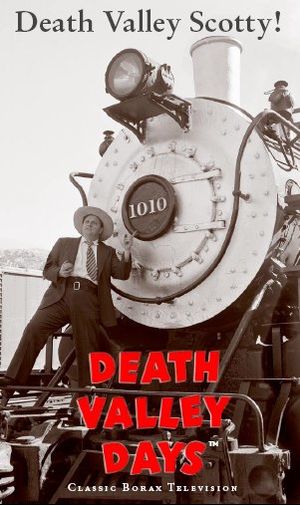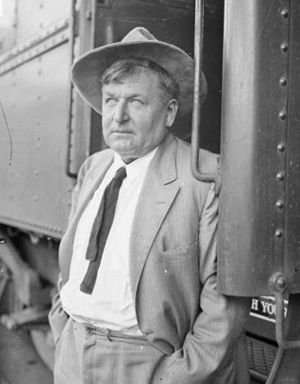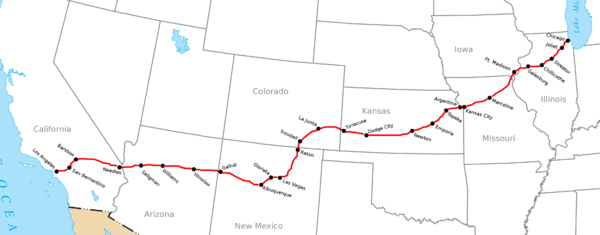Scott Special

The Scott Special, also known as the Coyote Special, the Death Valley Coyote or the Death Valley Scotty Special, was a one-time, record-breaking (and the best-known) passenger train operated by the Atchison, Topeka and Santa Fe Railway (Santa Fe) from Los Angeles, California, to Chicago, Illinois, at the request of "Death Valley Scotty". At the time of its transit in 1905, the Scott Special made the 2,265 mile (3645 km) trip[1] between the two cities at the fastest speed recorded to date; in doing so, it established the Santa Fe as the leader in high-speed travel between Chicago and the West Coast. The Scott Special made the trip in 44 hours and 54 minutes[2] breaking the previous records, set in 1900 by the Peacock Special, by 13 hours and 2 minutes,[3] and in 1903 by the Lowe Special, by 7 hours and 55 minutes.[4] Santa Fe's regular passenger service from Los Angeles to Chicago at the time was handled on a 2½-day schedule by the California Limited. It was not until the 1936 introduction of the Super Chief that Santa Fe trains would regularly exceed the speeds seen on the Scott Special.
Contents
Background
Death Valley Scotty (born September 20 1872, Walter Edward Scott) had used some ore samples he collected near Cripple Creek, Colorado, as a ruse to convince some bankers in 1902 that he had a claim on a high-grade ore mine in Death Valley, California. By 1905 he had conned the banks out of nearly $10,000. Another con he ran in 1905 earned Scott an additional $4,000. It was then that he met E. Burdon Gaylord, the owner of the Big Bell mine. Gaylord needed a flashy way to promote his mine and Scott sought the money behind the mine; the two formed a partnership where Gaylord would finance Scott and Scott would promote the mine like no other.
After a few high-priced and newsworthy train trips around the southwest, Scott met with the Santa Fe's General Passenger Agent, J. J. Byrne at the railroad's office in Los Angeles on July 8 1905. Once Scott (who had already travelled cross-country on the Santa Fe some thirty-two times) got in to talk to Byrne, the arrangements were made, thanks to a deposit from Scott of $5,500 in cash[5]. The two agreed on a 46-hour schedule from Los Angeles to Chicago that would begin the following day.[6][7]
The passenger list for the train was a mere four people: Scott himself, his wife, F. N. Holman, and C. E. Van Loon, a publicist for the Santa Fe. The schedule involved operating a three car train across the system, led by no less than 19 different locomotives (and the train was double-headed through some of the mountain passes). The engineers of these locomotives came to be known as the "Nervy Nineteen".[7]
Equipment used
The special train consisted of three passenger cars pulled by one locomotive. The three cars used were baggage car #210, dining car #1407, and Pullman Muskegon. Altogether, the three cars weighed a total of 170 short tons (155 tonnes).[8] While the three cars remained constant throughout the run of the Scott Special, the locomotive did not. In order to prevent delays on the trip as the train would need to stop for water and fuel, nineteen locomotives were prepared along the route so that as one reached the end of its supplies, it would relay the three cars off to the next fully fueled and ready locomotive to continue the run. For the more strenuous grades over Cajon Pass in California and Raton Pass in New Mexico and Colorado, helpers were added to get the train up and over the summits. At various points throughout the run, problems such as hotboxes did occur, or in one instance a complete mechanical failure of the locomotive, but in each case, the train's crew was able to get the train to the next relay point, and they usually arrived ahead of schedule.
| Locomotives and crews for the Scott Special[9][10] | |||||||
|---|---|---|---|---|---|---|---|
| Section | Distance | Average speed | Time | Locomotive number | Wheel arrangement (Whyte notation) |
Engineer | Fireman |
| Los Angeles - Barstow | 141.1 mi (227.1 km) | 48.5 miles per hour (78 km\h) | 2 hours 55 minutes | 442 | 4-6-0 | John Finlay | C. B. Ashbaugh |
| Barstow - Needles | 169.3 mi (272.5 km) | 51 mph (82.1 km/h) | 3 h 19 m | 1005 | 2-6-2 | Thomas E. Gallagher | E. D. Nettleton |
| Needles - Seligman | 148.9 mi (239.6 km) | 42.4 mph (68.2 km/h) | 3 h 31 m | 1010 | 2-6-2 | Fred W. Jackson | H. Nelson |
| Seligman - Williams | 50.8 mi (81.8 km) | 34.4 mph (55.4 km/h) | 1 h 29 m | 1016 | 2-6-2 | Charles Wood | R. Edgar |
| Williams - Winslow | 92.2 mi (148.4 km) | 42.1 mph (67.8 km/h) | 2 h 11 m | 485 | 4-6-0 | D. A. Lenhart | W. P. Sugurue |
| Winslow - Gallup | 128 mi (206 km) | 49.4 mph (79.5 km/h) | 2 h 35 m | 1000 | 2-6-2 | John F. Briscoe | B. F. Chambers |
| Gallup - Albuquerque | 157.8 mi (254 km) | 49.4 mph (79.5 km/h) | 3 h 12 m | 478 | 4-6-0 | Henry J. Rehder | F. Brown |
| Albuquerque - Las Vegas | 132.2 mi (212.8 km) | 44 mph (70.8 km/h) | 3 h 0 m | 1211 | 4-6-2 | Edward Sears | G. A. Bryan |
| Las Vegas - Raton | 110.8 mi (178.3 km) | 50.5 mph (81.3 km/h) | 2 h 12 m | 1208 | 4-6-2 | George A. Norman | E. Chrystal |
| Raton - La Junta | 104.5 mi (168.2 km) | 46.2 mph (74.4 km/h) | 2 h 17 m | 1215 | 4-6-2 | Hudson A. Gardner | R. P. Hinze |
| La Junta - Syracuse | 100.8 mi (162.2 km) | 63.7 mph (102.5 km/h) | 1 h 35 m | 536 | 4-4-2 | David Lesher | William McClerkin |
| Syracuse - Dodge City | 101.6 mi (163.5 km) | 62.2 mph (100.1 km/h) | 1 h 38 m | 531 | 4-4-2 | H. G. Simmons | G. Davis |
| Dodge City - Kent | 153.4 mi (246.9 km) | 57.9 mph (93.2 km/h) | 2 h 39 m | 530 | 4-4-2 | Edward Norton | C. L. Gray |
| Kent - Newton | 1095 | 2-6-2 | Oliver W. Halsey | ||||
| Newton - Emporia | 73.1 mi (117.6 km) | 62.6 mph (100.7 km/h) | 1 h 10 m | 526 | 4-4-2 | Hadley R. Rossetter | Andy Fairchild |
| Emporia - Argentine | 120.2 mi (193.4 km) | 57.3 mph (92.2 km/h) | 2 h 10 m | 524 | 4-4-2 | Josiah Gossard | H. H. Hill |
| Argentine - Marceline | 108 mi (173.8 km) | 54 mph (86.9 km/h) | 2 h 1 m | 547 | 4-4-2 | A. F. Bauer | Robert Shirk |
| Marceline - Shopton | 112.8 mi (181.5 km) | 55 mph (88.5 km/h) | 2 h 3 m | 542 | 4-4-2 | Richard Jones | J. J. O'Connor |
| Shopton - Chillicothe | 104.7 mi (168.5 km) | 62.3 mph (100.3 km/h) | 1 h 41 m | 510 | 4-4-2 | Charles Losee | W. M. Schlosser |
| Chillicothe - Chicago | 134.3 mi (216.1 km) | 61 mph (98.2 km/h) | 2 h 12 m | 517 | 4-4-2 | ||
Route and schedule
The special departed from Santa Fe's La Grande Station in Los Angeles at 1:00 PM Pacific Time on July 9 1905. The locomotive and three cars left the station and the cheering crowds, estimated at 20,000 people,[7] and began its run eastward. The number of people at La Grande Station is remarkable in itself since the train's schedule was planned only one day before the event; the Santa Fe used the train as an opportunity to publicize itself and got the word out to news agencies across the railroad's territory.
In rail transport terminology, the Scott Special operated as an "extra" train. Normally such trains are not allowed any special considerations for schedule and are switched into sidings to clear the main line for the railroad's regularly scheduled trains. For this run, however, the special was afforded rights over all of the railroad's regular trains; all other trains were required to clear the main line no less than one hour before the special was scheduled to pass. As most of the Santa Fe was still a single track railroad, this meant that quite a few regular trains were put into sidings to wait for the special. This accommodation, along with the numerous locomotive changes en route helped to ensure that the train would arrive in Chicago within the 46-hour schedule.
The first locomotive and crew change occurred in Barstow after the train had passed through Cajon Pass. At one point after passing Cajon summit, the train was clocked at 96 mph (155 km/h). The locomotive and crew were again changed successively at Needles, Seligman, Williams, Winslow and Gallup before the train arrived in Albuquerque, New Mexico at 9:30 AM on July 10.
To cross Raton Pass, locomotives and crews were changed at Las Vegas, Raton and La Junta. From La Junta, the train was powered by a succession of 4-4-2 type locomotives that were swapped across the plains in Syracuse, Dodge City, Newton, Emporia, Argentine and Marceline to the Mississippi River crossing at Shopton, Iowa, near Fort Madison. Locomotive 530 was scheduled to take the train completely between Dodge City and Newton, but a burst cylinder head in Kent necessitated adding locomotive 1095 for the 26 miles (41.8 km) between Kent and Newton.[10]
En route, Scott and his guests enjoyed the finest meals that the Fred Harvey Company had to offer. Menu selections included such luxurious offerings as caviar, iced consommé, and Porterhouse steak à la Coyote.[12]
One more locomotive and crew took the train to Chillicothe where it made its final locomotive change for the last leg into Chicago. Engineer Charles Losee piloted the train for its entire run across Illinois, at an average speed of 60 mph (97 km/h),[13] staying aboard the train during the locomotive change in Chillicothe. The train officially arrived at Dearborn Station at 11:54 AM Central Time on July 11.[14][15]
Legacy and preservation

The speed record set by the Scott Special stood for many years and was not beaten in regular service until the introduction of the Super Chief in 1936. What makes the Scott Special especially remarkable is that it was run under normal operating conditions.
- "[The] run was made under normal conditions of track, motive power, and equipment, and practically on a moment's notice. No racing machines were used. The locomotives were the plain, everyday kind, taken from regular runs and manned by employees taking their regular turn. To be sure, the main line was kept clear, and even the exclusive California Limited put on the side track. The Scott Special had the right-of-way. That was the only favor shown it, though the engineers understood they had permission to 'let her out a few notches,' and they did so, when they could with safety."[16]
In 1955, on the 50th anniversary of the special's run, the Scott Special was re-enacted for television. For the show "Death Valley Days", the production crew was able to reuse Santa Fe locomotive number 1010, the 2-6-2 locomotive that was used in the original run between Needles and Seligman (and the only unit still on Santa Fe's active roster). Robert Hinze, a fireman on the original Scott Special, was on hand to aid in the recreation as the replica train worked over Cajon Pass in California.[17] In October 1984, the Santa Fe donated locomotive 1010 to the California State Railroad Museum, where it remains on static display.[18][19]
The 100th anniversary of the Scott Special was commemorated with localized events and interpretive displays along the train's route sponsored by various historical organizations. One such display was shown at Joliet, Illinois, by the Blackhawk Chapter of the National Railway Historical Society; the Scott Special passed Joliet just after 11:00 AM on July 11 1905.[20]
Today, Amtrak's daily Southwest Chief follows nearly the same route as the Scott Special. As of 2006, the Southwest Chief makes the journey in just under 43 hours, departing Los Angeles Union Station at 6:45 PM Pacific Time, and scheduled to arrive at Chicago Union Station at 3:20 PM Central Time on the second day of the trip.[21]
References
General
- Armitage, Merle (1973, reprinted 1986). Homage to the Santa Fe. Hawthorne, California: Omni Publications, pp 87-92.
- Bryant, Jr., Keith L. (1974). History of the Atchison, Topeka and Santa Fe Railway. Trans-Anglo Books, Glendale, CA. ISBN 0-8032-6066-0.
- Duke, Donald (1997). Santa Fe...The Railroad Gateway to the American West, Volume 2. Golden West Books, San Marino, CA. ISBN 0-87095-110-6.
- Signor, John R., compiler (first quarter 2006). "Death Valley Scotty's 'Coyote Special'". The Warbonnet 12 (1): 17-29.
- The Record Breaking Run of the Scott Special: Los Angeles to Chicago in 44 hours & 54 minutes. Central Pacific Railroad Museum. Retrieved on March 20, 2006.
- Waters, Leslie L. (1950). Steel Trails to Santa Fe. Lawrence, Kansas: University of Kansas Press, pp 389-392.
Specific
- ↑ Armitage, p 87
- ↑ Signor, p 24
- ↑ Signor, p 18
- ↑ Waters, p 389
- ↑ Bryant, p 213
- ↑ Signor, pp 17-18
- ↑ 7.0 7.1 7.2 Waters, p 390
- ↑ Signor, p 19
- ↑ Signor, p 25
- ↑ 10.0 10.1 Baldwin Locomotive Works (1906). The Atchison, Topeka and Santa Fe Railway System: The Scott Special. Retrieved on 2006-05-09.
- ↑ Signor, pp 20-21
- ↑ Bryant, p 215
- ↑ Waters, p 391
- ↑ Signor, pp 19-25
- ↑ The Santa Fe "Chief". Mike's Railway History (March 2006). Retrieved on 2006-05-09.
- ↑ Armitage, p 89
- ↑ Signor, pp 27-28
- ↑ California State Railroad Museum Foundation (2001). Library & Collections: Steam Locomotives. Retrieved on 2006-05-09.
- ↑ 1010 as seen in 1995
- ↑ Pinn, Jacqueline (2005). Club keeps railroad history on track. Catholic Explorer. Retrieved on 2006-05-12.
- ↑ Amtrak. Southwest Chief Timetable (PDF). Retrieved on 2006-06-02.
Further reading
- Miller, Harry I. (1980). The Mad 2265 Mile Dash of the Scott Special. Black Cat Press. ASIN B0006XPI44.
See also
- Passenger train service on the Atchison, Topeka and Santa Fe Railway
- Scotty's Castle



